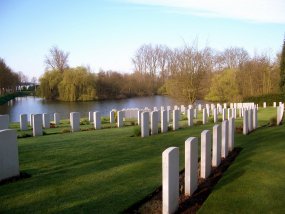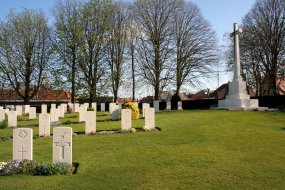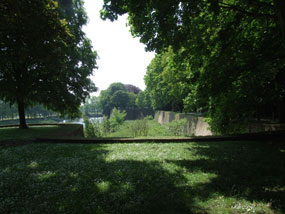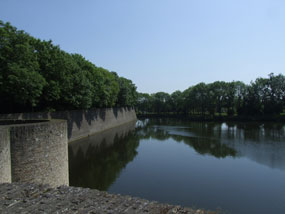
WWII: Maginot Line | Normandy | V-Weapon Sites | Arnhem
Further afield: Crete
| Home Tracing Military Ancestors Travel Advice CWGC Cemeteries Iron Harvest News Book Reviews Glossary Links Contact Me Ypres:
 
|
Core Location 3 – Ramparts CWGC Cemetery, Ieper
Directions – Leave the Grote Markt southwards via the Rijselsestraat (the road directly opposite the far end of the Cloth Hall). The cemetery is located on the old city ramparts to the right of Lille Gate at the end of the Rijselsestraat. Park in front of the bar on the right. Practical Information – Ramparts CWGC Cemetery is a good place to visit early on a sunny morning – giving the enchanting surrounding scenery of this cemetery added appeal. The Ramparts 1914-1918 War Museum is in the bar to the right of Lille Gate and is well worth a visit.
Historical Notes – The ramparts were built by the legendary French fortress engineer, Vauban, in the late 17th Century and extended by the Dutch in the early 18th Century. The cemetery here was begun by the French in 1914 and was used later by British Advanced Dressing Stations (ADS’s), which were quartered nearby. The French crosses have been moved but 153 British, 14 New Zealand, 11 Australian and 10 Canadian graves remain. It is one of the smallest cemeteries in the Salient but, without doubt, has one of the most beautiful settings, looking out on what used to be the moat of the town fortifications. Rose Coombs, whose book, "Before Endeavours Fade", is practically a "bible" to battlefield visitors, had her ashes scattered in this spot in 1991 and a signposted walk around the ramparts is named after her. Eyewitness Account – The peace and tranquillity of the ramparts today is in stark contrast to how H.S. Clapham remembers them in June 1915 in his book "Mud and Khaki": "The sun is shining, the birds are singing but beneath all other sounds there is one deep undertone, the buzzing of innumerable flies. On the other side of the moat there is a brickyard, some three hundred yards long. Broken beams stick out of the piles of bricks at intervals, but there is nothing else to show that the brickyard was once a row of cottages. A dead cow lies half in the water of the moat. Spurts of flame, every now and then, disclose the position of a British battery…as I watch, a huge shell bursts in the moat, raising a column of mud and water, and two others find the brickfield amid clouds of red dust. Each time a shell bursts, I duck while the debris patters among the surrounding trees." Extract taken from Flanders Then & Now, The Ypres Salient and Passchendaele by John Giles, Battle of Britain Prints International Ltd 1995. |
||||||||




